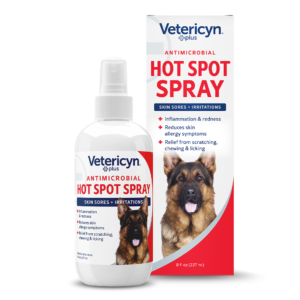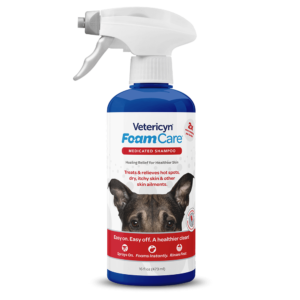Updated 7/15/2025
If you’re a Labrador Retriever parent, you know Labs love to be the life of the party—so when an unexpected skin issue pops up, it can be a real party-pooper.
With the proper knowledge and dog care solutions, treat Labrador Retriever skin issues and get your Lab back to partying shape in no time.
Why Do Labs Develop Skin Problems?
All dogs can suffer from skin problems; however, Labrador Retrievers have a few risk factors that increase their odds of skin troubles. These include:
- Histamine – Labradors produce a significant amount of histamine, which can cause inflammation and itch, potentially making them more prone to skin allergies and reactions.1
- Fur coats – It’s no secret that Labs shed. This breed has thick coats, so dirt and moisture can build up, setting the stage for bacteria to cause skin problems.
- Genetics – Parents can pass allergic tendencies to their puppies. Even if the parents don’t have allergies, the puppies can still have them.1
But don’t let this stop you from choosing a Labrador retriever as a lifelong companion! Labs are healthy (and adorable) dogs, and many skin ailments can be swiftly treated, especially when caught early.
Tell-Tail Signs of Labrador Skin Problems
Keeping an eye on your pup’s coat for any unusual changes is the best way to spot a problem. Look for2:
- Patchy fur
- Flaky skin
- Redness, swelling, and crusts
- Unpleasant odors
If you notice your Lab frequently biting, scratching, or licking the same spot, it’s time to get them to the vet.
Common Labrador Retriever Skin Problems
When a patch of skin turns troublesome, there are a few likely culprits:
- Allergies
- Dermatitis
- Fleas and ticks
Your veterinarian can help identify the cause and develop the right treatment plan.
#1 Food Allergies
Just like humans, dogs can be allergic to specific foods, and food allergies can sometimes trigger skin problems and other issues, such as bowel irritation.
#2 Contact Allergies
Contact allergies occur when your dog encounters an irritant in the environment, including:3
- Dyes
- Carpet shampoo
- Plant irritants (such as poison ivy)
- Road salt
- Rubber
Labrador retrievers’ thick coat protects most of their skin from environmental irritants. But hairless and less-covered areas of your dog’s skin are vulnerable.
#3 Flea Bites
Fleas love to hitch a ride beneath your pet’s fur and chomp away at their skin. If fleas have infiltrated your pet’s coat, you will likely notice frequent scratching or biting of the problem area (usually the back or tail). Flea saliva may trigger an extremely itchy allergic reaction in dogs.
Skin reactions to flea bites may be local or generalized throughout the coat. Over time, constant scratching can cause bites to develop into flaky, oozing, and painful areas known as hot spots.
#4 Dermatitis and Hot Spots
Traumatic moist dermatitis, aka a hot spot, is a red, moist, and oozing lesion characterized by hair loss and a halo of red skin.6
Without treatment, hot spots progress rapidly and are painful. They are caused when an underlying factor triggers pain and itch, prompting the dog to bite, lick, and scratch the area in an attempt to find relief.6 Hot spots may contain bacteria, but they are not skin infections. They typically occur in breeds with heavy, dense undercoats, such as Golden Retrievers, Labrador Retrievers, German Shepherds, and St. Bernards; however, any breed may develop hot spots.6 Hot spots may occur in any season, but are more common during moist, warm weather.6 Hot spot triggers include6:
- External parasites, especially fleas
- Allergic skin disease
- Anal sac problems
- Otitis externa
- Coat foreign bodies
- Irritants
- Dirty coats
- Psychoses
- Muskuloskeletal pain
Hot spots may occur anywhere on the body but commonly appear near the trigger point such as infected ears, anal sacs, and around the rump.6
Treating Labrador Skin Problems
Your Lab’s treatment plan will depend on your vet’s diagnosis. While every case is unique, there are a few standard approaches.
Eliminating Allergens
Antihistamines and (in some cases) antibiotics can help treat skin reactions that stem from food and contact allergies, but the symptoms will resurface if they are still exposed to the allergen.
If your vet suspects a canine food allergy, they’ll guide you through a diet elimination trial to identify what your dog is allergic to and remove it from their diet.
When it comes to contact allergies, treatment involves ruling out other potential causes of allergies and testing for specific allergens until the offender is identified and removed.
This can take time, so patience, close observation, and communication with your veterinarian are key.
Soothing Flea Bites
Flea bite allergies must be treated holistically, encompassing the affected pet, other pets in the household, and the environment both inside and outside the house. Fleas must be killed and eliminated; otherwise, the problem will persist.7
Regular flea and tick treatment prevents the problem. But if your dog has flea allergy dermatitis, they will be treated for fleas and the pain and inflammation caused by the allergic reaction to the flea saliva. Your veterinarian may prescribe steroids and possibly antibiotics if an infection has developed.7
Cooling Off a Hot Spot
When a hot spot develops, treatment plans usually include:
- Fur trimming – Trimming the hair helps dry the area and promotes healing. Leave this to the vet, as the area is painful and sedation or pain medication may be needed.
- Coat cleaning – An antiseptic shampoo, such as Vetericyn FoamCare Medicated Pet Shampoo, can help remove debris and moisture that contribute to hot spot symptoms.
- Lick prevention – This means no licking, biting, or scratching—so a protective Elizabethan collar may be necessary. Consider applying Vetericyn Plus Antimicrobial Hot Spot Spray, which helps decrease itch and soothe pain, reducing the urge to lick and promoting healing.
With proper dog wound care treatment, a hot spot will start to heal roughly one week after treatment begins, and your dog’s fur should start to grow back after about 2 to 3 weeks.5
How to Prevent Labrador Skin Problems
Prevention is the best medicine. Try these tips to prevent ongoing lab skin problems:
- Flea and tick prevention
- Proper diet
- Regular grooming
- Dry thoroughly
By taking these steps, you can stop Labrador skin problems in their tracks—and keep your best bud trotting along in his.
Healthy Skin, with Vetericyn
At Vetericyn, we understand that your pet is a valued family member and their well-being is one of your top priorities. That’s why we’ve crafted a line of premium pet care products. Veterinarians worldwide trust Vetericyn to help them optimize their patients’ health and wellness.
Explore the Vetericyn collection today.
 Reviewed by C. Scott Van Winkle
Reviewed by C. Scott Van Winkle
Scott has been with Innovacyn for the past 11 years and has been working within the Burlingame portfolio of companies for the past 23 years. Scott brings a diverse background to Innovacyn. With an upbringing as the 5th generation on his families cattle ranch, Scott has a passion for animal health and the continuous improvement surrounding agricultural practices. Scott earned marketing and business management degrees from the University of Idaho and holds an Executive MBA from Pepperdine University.
Sources:
- PetPlan. Is your Labrador prone to skin allergies? https://www.petplan.co.uk/pet-information/dog/advice/skin-allergies-in-labradors/
- VetsNow. A guide to dog skin conditions. https://www.vets-now.com/pet-care-advice/dog-skin-conditions/
- The Labrador Site. Common Allergies in Labrador Retrievers. https://www.thelabradorsite.com/common-allergies-in-labrador-retrievers/
- Small Door Veterinary. Hot Spots on Dogs. https://www.smalldoorvet.com/learning-center/what-to-do/hot-spot-in-dogs
- Whole Dog Journal. Dog Hot Spot Healing Stages. https://www.whole-dog-journal.com/health/dog-hot-spot-healing-stages/
- Miller WH, Griffin CE, Campbell KL. Environmental Skin Diseases. In: Miller WH, Griffin CE, Campbell KL, eds. Muller and Kirk’s Small Animal Dermatology. 7th ed. St. Louis, MO: Elsevier Mosby; 2013:677.
- Dryden MW. Flea Allergy Dermatitis in Dogs and Cats. Merck Veterinary Manual. https://www.merckvetmanual.com/integumentary-system/fleas-and-flea-allergy-dermatitis/flea-allergy-dermatitis-in-dogs-and-cats. Accessed July 1, 2025.



